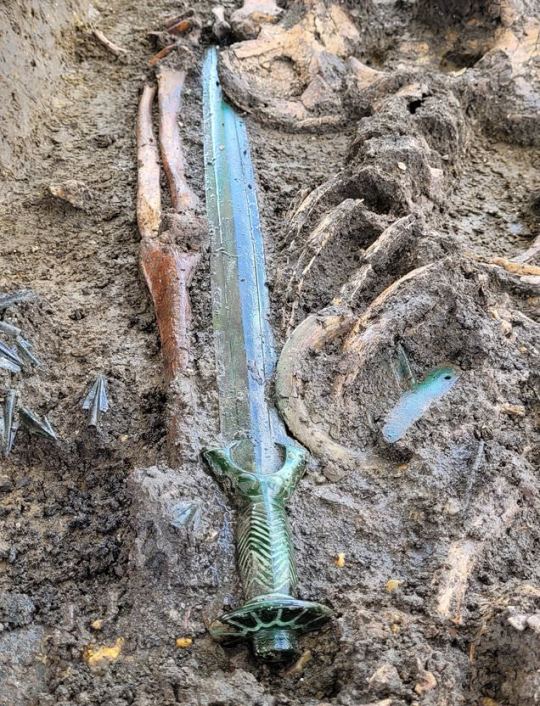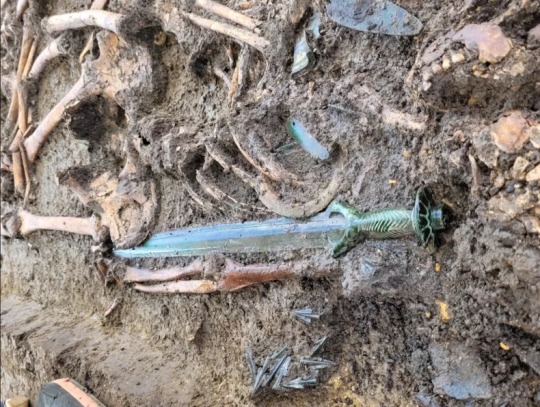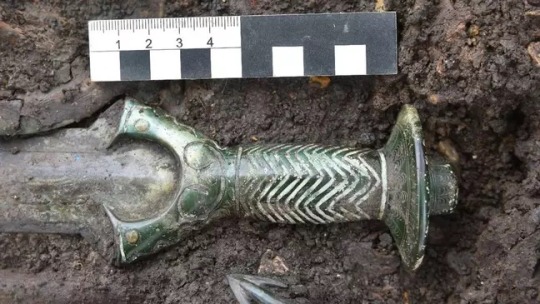Text

Apollo Command Module, Impact Test, El Centro California, 1962
199 notes
·
View notes
Text

24 July 1969, CV-12 USS Hornet prepares to recover Apollo 11 Command Module Columbia.
342 notes
·
View notes
Text





USS ARKANSAS (BB-33) tied to a pier at the Norfolk Navy Yard, Virginia. She had just undergone a rebuilt of her forward superstructure, which replaced her lattice mast with a tripod mast.
Photographed on June 26, 1942.
source
124 notes
·
View notes
Text

Archaeologists Find a Beautiful 3,000-Year-Old Octagonal Sword in Germany
A rare Bronze Age sword unearthed from a burial site in Germany is in such good condition that it still glimmers.
According to a statement the Bavarian State Office for Monument Protection released on Wednesday, the weapon was discovered in the town of Nördlingen in Bavaria, and may date to the 14th century B.C.
"Last week, archaeologists made a very special find during excavations in Nördlingen: a bronze sword that is over 3,000 years old and is so extraordinarily well preserved that it almost still shines. It is a representative of the bronze full-hilt swords, whose octagonal hilt is made entirely of bronze (octagonal sword type)," a translation of the statement reads.

Its octagonal shape make it a rare find, as only the most skilled blacksmiths were capable of making these types of swords—known as Achtkantschwert in German—that required precise casting and decoration.
"The production of octagonal swords is complex because the handle is cast over the blade (so-called overlay casting). The decoration is made with an inlay and using hallmarks. While there are two real rivets, another pair of rivets are only implied," the statement said.
These rare and specialized swords were only made in two locations in Germany at the time, one in the north, one in the south, although the exact location of this sword's origin could not be confirmed.

This find is especially unusual considering that most burial mounds in the area of Germany where the sword was discovered have been opened and looted in the past.
"Sword finds from this period are rare and come either from burial mounds that were deliberately opened in the 19th century or as single, presumed sacrificial finds," the statement said.
It is unclear if this octagonal sword was ever used in combat, or if it was a ceremonial blade.
However, archaeologists noted that while the blade had no signs of wear in battle, its center of gravity made it suitable for use as a real weapon, and it was capable of being used to slash opponents.

The grave in which the sword was found contained the remains of a man, a woman and a child.
"It is not yet clear whether the persons were related or what the relationship between them was," the statement explained.
Despite these questions, the sword marks an exciting find for the archaeologists and for Germany.
"The sword and the burial still have to be examined further so that our archaeologists can classify this find more precisely. But it can already be said that its condition is exceptional. A find like this is very rare," Mathias Pfeil, head of the Bavarian State Office for the Preservation of Monuments, said in the statement.

4K notes
·
View notes
Text
The Future of Warfare
A Tachibana Clan story
Tachibanayama, Chikuzen province, 1549.
~¥~
"Honored grandfather, today I have an incredible gift to show you."
The boy, Hiroshi, still 13 and with a way to grow, knelt in his fine blue kimono. His head bowed, he held before him something that no one else in the room, and few in Japan, had ever seen at the time.
The object was long, and seemed reminiscent of a metal staff with an ornamented wooden end. Hiroshi's grandfather, Tachibana Motosuke, was daimyo of the clan, and beckoned his grandson closer.
"Come here, my boy. My eyes are not yet so old, yet I can not make out this item. Is it some sort of staff? A club, perhaps?"
Hiroshi almost leapt to his feet in excitement, delivering the exotic object to his grandfather.
"No, lord grandfather, though your wisdom is clear! It is indeed a weapon, but one unlike any I have seen. It is called a "Tanegashima weapon", as it comes from Tanegashima, where the lord purchased the first ones from the Nanban. It reminds me of the teppo I saw in the war histories, when the Mongols came."
Motosuke examined the weapon, its length and heft, the craftsmanship of the steel barrel. It was easy to hold in the hands, but seemed too thin to be of real use.
"Hmmmm... My own grandfather fought in the Onin War, in Kyoto. He was part of a troop that used a teppo, but he said it was quite large and unruly. You say this is like that?"
"Yes, but far more effective. Grandfather, may I demonstrate it for you?"
Motosuke nodded to his grandson, handing the weapon back. Hiroshi's eyes lit up with more excitement than they already held, and with a dignified call that belied his young age, he beckoned all in the room to go out to the archery range.
"Come, gentlemen! Please allow me the honor of showing you this fascinating weapon of war from far off lands! Let us go outside, for this weapon is dangerous to use indoors."
And without even waiting, Hiroshi dashed out the doors. Motosuke turned to his eldest son, Tamenori, Hiroshi's father, with a chuckle echoing out from his blustery moustache.
"Your boy is certainly precocious, Tamenori!"
"Agreed, father! He will make a fine and clever leader one day. But how will anyone be able to keep pace with him?" Tamenori let out a proud laugh at saying this, shining the charming smile that had made Tamenori the love of women (and some men) all across Kyushu.
Certainly, Tamenori had much to be proud of in his eldest son. Hiroshi was a brilliant boy, who revelled in the new and the inventive. He had already at 13 read more books than this father, including learning the Chinese language to read Sun Tzu's Art of War in its original script. He loved poetry, and though his older sister outshone him in writing, he still loved to play with language. He was especially adept with games, regularly enjoying his Go matches with his grandfather. Hiroshi loved to go to the markets and see what interesting knickknacks were there, delighting in clever mechanisms and fine craftsmanship. And though his clan found it odd, he was known for spending his time studying at the blacksmith forges. He liked to set aside his books to watch the smiths at work, see the techniques they used. In later eras, in other parts of the world, he would be called a "polymath."
As the clan followed young Hiroshi outside, they saw he had run far ahead, and already had set up two targets. When everyone had gathered, he began his explanation by standing at attention and giving his voice an endearing attempt at depth.
"Gentlemen! Honored clan members! Today I am demonstrating for you the future of warfare! This marvelous weapon that I hold is called the Tanegashima, or "Arquebus" (Hiroshi struggled to frame this word, but spoke it with as much confidence as he could muster). They originate in a far off country of the Nanban that arrived just a few years ago. This is a ranged weapon that will outmatch any other we have today!"
He held the gun standing by his side, though it was longer than Hiroshi was tall, having not yet hit his growth. Even in his excitement, he treated the weapon with respect.
"The Tanegashima has greater range and power than any bow, even fired by a master. To show you this, I have set up two targets. Each has pieces of armor which obscures a melon. We will first fire a bow, and see how the arrow penetrates the armor and into the melon. Then we will do the same with the Tanegashima. May I ask, which valiant samurai here would demonstrate his archery prowess by striking the melon behind the armor?"
Hiroshi's uncle, Motoshige, stepped forward. Though younger than his brother Tamenori, Motoshige was a beast of a man, with a known skill for the bow. He took up a yumi and arrow.
"So, nephew, I simply shoot the target?"
"Why yes, uncle, with all your strength! Show us the great valor of an archer of the Tachibana!"
With a huff, Motoshige raised his bow, aiming and then releasing his arrow with great force. It struck the armor mightily, and even from afar it was almost heard to crack. Hiroshi led everyone to the target, showing that though the arrow rang true, it had only just pierced into the flesh of the melon. A wound, but it would not be a fatal one for the melon nor the warrior that it was imitating.
"An excellent shot, uncle! If that hit an unarmored target they would surely be slain, and even an armored one will be hurt. But noble samurai, we are not all so skilled a shot as my mighty uncle! Certainly, a boy like me with arms so think could not match your skill with a bow. But come, now let us see the power of Tanegashima."
He led the group back to the firing area. There, he once again hefted the exotic musket.
"I must ask once more for a volunteer. Alas, I am yet too short to prepare this weapon easily. Who will assist me in learning this technique?"
Tamenori stood forward now with a cocky grin.
"Well! A father should help his son, especially when his brother has just shown such talent! Come my boy, what is it I must do?"
Hiroshi instructed Tamenori through the loading process, making sure everyone present could see how it was done as well. Though it took some time, with multiple steps that must be done in a proper order, he assured everyone this would be easier with practice. Once ready, his father held the weapon out again to his son.
"Is this weapon truly as mighty as you say it is?"
"Yes father, I believe this demonstration will be quite definitive! I hope to show it is more powerful even than my uncle!"
"Then bring my line honor, and let my brother, skilled as he is, find a challenger today in this new weapon!"
The group laughed, including Hiroshi, Tamenori, and Motoshige. Their family was close, and enjoyed the spirit of competition and love between them. Surely, there was nothing that a young, skinny child like Hiroshi could use that would match Motoshige's shot?
Hiroshi lifted the musket to his shoulder, as he had practiced since acquiring it. He readied the matchlock. Though the gun was long, he held it steady as he aimed it at his target. Satisfied, he pulled the trigger.
The noise was loud, prompting some of the gathered to cover their ears. A swift roar like a thunderclap echoed out, and a bout of flame burst forth from the gun barrel. When the bullet hit its mark, another crack resounded in the air. Hiroshi turned back to the crowd with a smirk.
"Amazing! Shall we see the results?"
When the group arrived at the target, they could hardly believe their eyes. The armor had a hole clean through it, and more than that, the melon behind it had been burst! A murmur rustled through the clan members. Hiroshi, beaming with pride, spoke loud as he could to overcome the bustle.
"Look! Though I am young and small, my weapon has far surpassed even our greatest warrior! I tell you, this is the future of warfare!"
~¥~
6 years later, Hiroshi, now come of age and taking the name "Tamenaka" after a favorite poet, sat atop his horse on the battlefield. He gazed down from the hilltop at the oncoming Otomo forces. He remembered fondly that day, the pride he felt when his grandfather had listened and ordered a first set of the Tanegashima. Today would be the day that he finally showed the clan what this weapon could truly do on the battlefield.
He felt a pang of sadness that his grandfather, Motosuke, had passed during the winter, and would not get to see the results of his faith in his grandson. But his father, Tamenori, now daimyo of the Tachibana, had entrusted young Tamenaka with 500 of the newly made Tanegashima. He had trained his unit to fire in volleys, to stand in a firm line, to swiftly reload.
Today in 1555, is the Battle of Mihara, where Tachibana Tamenaka would revolutionize the way of warfare in Japan. As his volleys tore into the charging ashigaru, Tamenaka felt the roar of 500 guns and saw the fear erupt into the enemy lines. Within mere moments the enemy fled, with few even reaching the Tachibana lines. As the rest of the Tachibana clan overran the enemy lines, all knew the moment of victory had come with the roar of Tamenaka's volleys.
The future of warfare had come to the battlefield. And soon, the name of Tachibana Tamenaka would be heard in halls all across Japan.
1 note
·
View note
Text
In my Tachibana Clan Chronicles, I'll be writing a series of vignettes and stories focusing on a fictional samurai clan based out of Kyushu in the 1500's.
The basis for these stories is the game series Nobunaga's Ambition, set in Sengoku Japan. These games (along with their sister titles, Romance of the Three Kingdoms, regarding Three Kingdoms era China) are grand strategy games with an emphasis on the individual leaders and commanders (referred to as "officers") who made this era near legendary.
In brief, this setting is Japan in the 1500's, a time of tumultuous warfare and chaos as individual clan leaders, called daimyo, vied for power while the authority of the Shogunate rapidly dwindled. This era took a great turn after the arrival of Portuguese traders in 1543, on the island of Tanegashima, off the southern coast of Kyushu. This began a 100 year period of trade with westerners (referred to as Nanban, or "southern barbarians").
Perhaps most important from this trade was the introduction of the arquebus, a matchlock musket that would become synonymous in Japan with the island they first arrived on. Once smiths in Japan learned to forge the weapons, they spread like wildfire. It is believed that hundreds of thousands of the weapons were manufactured over the next 100 years, before falling into disuse during the peaceful (and isolated) Tokugawa shogunate. The games' eponymous Oda Nobunaga was renowed for his tactical use of the Tanegashima, which led him to a rapid conquest of much of central Japan.
In our story, things will be slightly different. For one, we are following the custom clan that I created for this game, the Tachibana. The Tachibana are initially based out of Tachibanayama, a real castle in northern Kyushu.
In real history, the Tachibana were a family with roots long in the past, connected to the Imperial lineage. However, by the time of the conflicts that led to the rise of the Shogunate in the 1100's, the Tachibana family had become largely politically irrelevant. It would not be until 1571 that a samurai named Bekki Akitsura would be entrusted by his daimyo, Otomo Sorin, with Tachibanayama, at which point Bekki Akitsura changed his name to Tachibana Dosetsu, thus briefly restoring a lineage of Tachibana.
In this fictional account, we find our Tachibana beginning with Tachibana Motonobu, a samurai who fought in the Onin War in the mid 1400's which began to shake the power of the Shogunate. Motonobu may or may not have been born a Tachibana, but certainly when he arrived in Kyoto to serve the Shogun, he was claiming this name. He, his son, and his grandson would all serve the Ashikaga shoguns for good portions of their lives.
However, by 1521, the situation in the capital had grown tumultuous. The current shogun had lost favor in the court as a rival of the Hosokawa prepared to oust him. Seeing a chaotic time on the horizon, Tachibana Motosuke left the capital, along with his wife, 4 children, and a small entourage of like minded officials and samurai. By the end of the year, they would arrive at the court of Ouchi Yoshioki, who was a friend to the now-removed Shogun. There, Motosuke offered his services in exchange for a claim to the Tachibanayama castle, citing his familial name as rights.
Over the next 30 years, Motosuke would lead his clan to steadily expanding his domain. His 4 children, 3 sons and one daughter, all proved themselves as excellent leaders, not least of all the eldest, Tamenori. Tamenori was one of the finest warriors all of Japan. And he was known as the most handsome samurai in Kyushu. His jovial nature charmed everyone he met, and he was certainly an inspiring young leader (though he certainly held grudges, particularly against Otomo Sorin after the two had fought to claim Moji castle).
My game began in 1553, and over the next 5 years first Motosuke, and then tragically Tamenori as well, would pass away due to illness. By 1559, this left the clan in the hands of the 23 year old Tamenaka. This young and clever leader found himself entering a stage shared with brilliant daimyo such as Mori Motonari, Takeda Shingen, Uesugi Kenshin, and of course, the eponymous Oda Nobunaga. Would he be the man to unite Japan, or would he be just another falling star? Well, it's 1572 in my playthrough now, and I can safely say, it's been a thrilling adventure.
0 notes
Text
Tachibana Clan Masterpost
This post will be used for links and summary for my account of the (fictional) Tachibana clan I created in my playthrough of Nobunaga's Ambition: Awakening.
I hope to share with you not only these stories, but also information on the real history of Sengoku era Japan, when the game takes place. Please enjoy!
0 notes
Text
Might just fuck around and turn this into a lowkey grand strategy AAR blog.
0 notes
Text

Ornate dagger with gold engravings and blued blade, Europe, late 18th century
from Czerny's International Auction House
10K notes
·
View notes
Text



Sword with Scabbard of Faustin I (1782–1867), Emperor of Haiti, circa 1850
from The Metropolitan Museum of Art
346 notes
·
View notes
Text

Sword, Korea, 17th-19th century
from The National Museum of Korea
85K notes
·
View notes
Photo




Astronomical Clock 1540, Munster, Westfalen. Photo credit
32K notes
·
View notes
Photo




Pearl mounted Japanese wakizashi, late koto or early shinto period.
from Sofe Design Auctions
5K notes
·
View notes
Photo

Sword Guard (Tsuba), Bairyūken Kiyotatsu, late 18th century, Metropolitan Museum of Art: Arms and Armor
H. O. Havemeyer Collection, Bequest of Mrs. H. O. Havemeyer, 1929
Size: H. 3 ¼ in. (8.3 cm); W. 3 in. (7.6 cm); thickness 3/16 in. (0.5 cm); Wt. 3.7 oz. (104.9 g)
Medium: Iron, gold, copper-gold alloy (shakudō)
https://www.metmuseum.org/art/collection/search/34456
189 notes
·
View notes
Text




Japanese tanto with carved bone mounts, 19th century
from Sofe Design Auctions
531 notes
·
View notes




